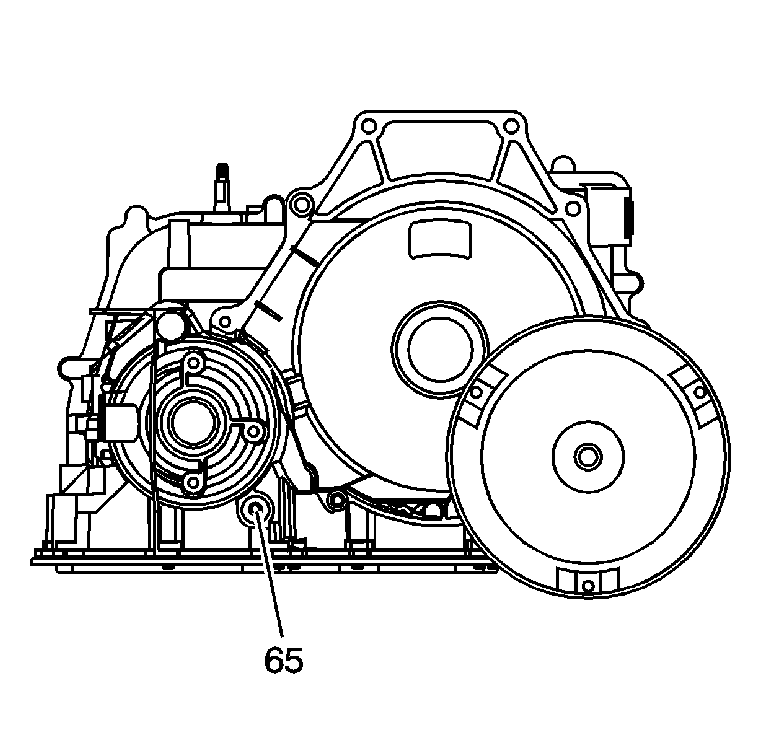
The oil level control plug (65) is located on the torque converter side of the transmission right hand axle seal passenger side.
Step | Action | Value(s) | Yes | No |
|---|---|---|---|---|
1 |
Caution: The engine must be running when the transmission fluid fill plug is removed, or excessive fluid loss will occur. Transmission fluid may be hot. Since the actual fluid level is unknown, stand clear when removing the fill plug. Have a container ready to capture any lost fluid. Do not turn the engine off with the fill plug removed, as you can be injured by hot transmission fluid being expelled out of the oil fill opening. Important: The transmission fluid may darken with normal use and does not always indicate contamination or oxidation. Is the fluid color clear red or light brown with no burnt odor? | At least 40°C (104°F) | Go to Step 4 | Go to Step 2 |
2 | Does the fluid have a burnt odor or a dark brown color? | -- | Go to Step 8 | Go to Step 3 |
3 | Does the fluid have a cloudy or milky appearance? | -- | Go to Step 7 | Go to Step 8 |
4 | Check the fluid level. The fluid level should be even with the bottom of the threaded plug hole. Is the fluid level low? | -- | Go to Step 5 | Go to Step 11 |
5 | Add DEXRON®VI automatic transmission fluid in increments of 0.5 L (0.5 qt) until the fluid drains from the plug hole. Did you add more than 1.5 L (1.6 qt) to the transmission? | -- | Go to Step 6 | Go to Step 11 |
6 | The transmission may have a leak. Refer to Fluid Leak Diagnosis. Was a transmission fluid leak found? | -- | Go to Step 9 | Go to Step 11 |
7 | The transmission fluid is contaminated with engine coolant. Repair or replace the transmission cooler in the radiator. Is the transmission cooler repair complete? | -- | Go to Step 9 | -- |
8 |
Important: A very small amount of material in the bottom of the bottom pan is a normal condition. Was excessive debris found? | -- | Go to Step 9 | Go to Step 10 |
9 |
Caution: The engine must be running when the transmission fluid fill plug is removed, or excessive fluid loss will occur. Transmission fluid may be hot. Since the actual fluid level is unknown, stand clear when removing the fill plug. Have a container ready to capture any lost fluid. Do not turn the engine off with the fill plug removed, as you can be injured by hot transmission fluid being expelled out of the oil fill opening. Notice: Use the correct fastener in the correct location. Replacement fasteners must be the correct part number for that application. Fasteners requiring replacement or fasteners requiring the use of thread locking compound or sealant are identified in the service procedure. Do not use paints, lubricants, or corrosion inhibitors on fasteners or fastener joint surfaces unless specified. These coatings affect fastener torque and joint clamping force and may damage the fastener. Use the correct tightening sequence and specifications when installing fasteners in order to avoid damage to parts and systems. Important: Before installing the fill plug, apply GM P/N 12345382 (Canadian P/N 10953489) to the thread of the line pressure plug. Is the repair complete? | At least 40°C (104°F) 12 N·m (9 lb ft) | System OK | -- |
10 |
Caution: The engine must be running when the transmission fluid fill plug is removed, or excessive fluid loss will occur. Transmission fluid may be hot. Since the actual fluid level is unknown, stand clear when removing the fill plug. Have a container ready to capture any lost fluid. Do not turn the engine off with the fill plug removed, as you can be injured by hot transmission fluid being expelled out of the oil fill opening. Notice: Use the correct fastener in the correct location. Replacement fasteners must be the correct part number for that application. Fasteners requiring replacement or fasteners requiring the use of thread locking compound or sealant are identified in the service procedure. Do not use paints, lubricants, or corrosion inhibitors on fasteners or fastener joint surfaces unless specified. These coatings affect fastener torque and joint clamping force and may damage the fastener. Use the correct tightening sequence and specifications when installing fasteners in order to avoid damage to parts and systems. Important: Before installing the fill plug, apply GM P/N 12345382 (Canadian P/N 10953489) to the thread of the line pressure plug. Is the repair complete? | At least 40°C (104°F) 12 N·m (9 lb ft) | System OK | -- |
11 |
Notice: Use the correct fastener in the correct location. Replacement fasteners must be the correct part number for that application. Fasteners requiring replacement or fasteners requiring the use of thread locking compound or sealant are identified in the service procedure. Do not use paints, lubricants, or corrosion inhibitors on fasteners or fastener joint surfaces unless specified. These coatings affect fastener torque and joint clamping force and may damage the fastener. Use the correct tightening sequence and specifications when installing fasteners in order to avoid damage to parts and systems. Important: Before installing the fill plug, apply GM P/N 12345382 (Canadian P/N 10953489) to the thread of the line pressure plug. Is the repair complete? | 12 N·m (9 lb ft) | System OK | -- |
